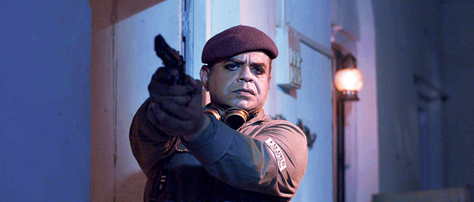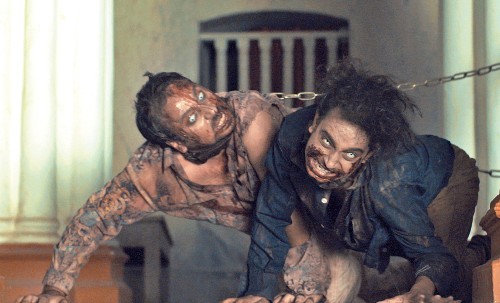In Zombiesthaan, a deadly bio chemical weapon has spread across the world, infecting 60 per cent of the population, in 2030. Infected ones lost their sanity and went into a regressive mental state. How did you arrive at this idea for the film?
The idea of the film came to me after I had an argument with a childhood friend over a political issue. I realised that my friend was not adhering to any logic and was just blindly supporting a certain political leader and ideology. He was not seeing reason. I felt as if he had turned into a regressive, mindless being, like a zombie. I realised that in one way or the other, in the current socio-political scenario, we all have turned into mindless creatures blindly pursuing something, or following someone. This led to the ideation of the film.
What did you want to convey through the plotline?
I wanted this film to act as a warning. All the incidents shown in the film, no matter how outlandish, are inspired from real incidents I have read about in newspapers. For example, the regime of Raja Horidas in the second half of the film, is inspired by activities of the ISIS. While writing the film, the intention was to depict real, shocking incidents, in an entertaining way, so that people can realise that we are headed towards a really dark future. If we do not alter our ways, the world shown in the film will come to life in the near future.

Rajatava Dutta Sourced by the correspondent
Do you feel this post-apocalyptic film will find resonance in today’s world where the human race is locked in a struggle to free itself from Covid?
Well, people have experienced dystopia in their day-to-day lives due to the Covid-19 pandemic, and films like Zombiesthaan do not seem far-fetched any more. Even during the pandemic, a lot of audiences who had seen the film at the time of its theatrical release had contacted me and stated that they found the film to be prophetic. I think the film is more relevant than ever now.
Was the camera angle for the scene where Akira (Tnusree) is tortured by Raja Horidas with a pair of scissors, referenced from the tunnel scene in Irreversible?
We honestly didn’t think of Irreversible while setting up that scene. Fact is, we had a very small room to shoot that sequence and this was the only camera angle that would get us the desired effect. We wanted to depict the violence of the scene suggestively through Akira’s expressions and the sound of a pair of scissors cutting away the clothes.

Rudranil Ghosh Sourced by the correspondent
What kind of music does the Raja like listening to? Was it Beethoven in the beginning?
We wanted to show Raja Horidas as a man of fine taste. He is seen being impressed by high quality liquor, maintaining a collection of the finest chocolates even in a dystopian world, etc. He has an eye for the good things in life. In the film, he has been shown enjoying Beethoven’s music.
On occasions you brought in very typical sound motifs, like the sound to mark the arrival of the Raja. Maybe they were used for humour. But do you feel they undermined the gravity of the situation on occasions?
We wanted a signature tune for Raja Horidas as he is a larger-than-life character. I don’t think it undermined the gravity of the situation. I wanted to use dark humour to keep the film entertaining, even in its most dark and violent scenes.

The zombies Sourced by the correspondent
How did you zero in on the locations, especially the forest area? What were the challenges of shooting there?
The locations were completely virgin and unexplored in cinema. They were rustic and beautiful, but the problem was that even the basic amenities needed for a smooth shoot, were unavailable. For example, we shot the first half at a desolate, deserted township called Cables Township, near Chittaranjan. The place was completely cut off from civilisation and the nearest hotel was 20km away. The forest is near Durgapur, but there were no accommodation options nearby. On top of all this, we had a shoestring budget. So, we could not even get make-up vans. We shot the film in peak summer in 2019 and it was extremely gruelling for the entire cast and crew. Thankfully, it was a passion project for everyone and every team member cooperated, even in the most difficult situations.
Tell us about your lead actors, Rudranil Ghosh, Rajatava Dutta and Tnusree. How did they give shape to the characters?
I wanted Anil (Rudranil) to be a really generic, calm person who everyone could relate to and trust easily. This would intensify the shock related to his final reveal. Rudranil is my go-to actor when it comes to layered, weird, complex characters. He played Anil with an underrated perfection which made him chilling. Rajatava was my first and only choice for the over-the-top Raja Horidas and he owns the character. We had a blast bringing the character to life. It was Rajatava who suggested the usage of kohl and eyeliner and the effeminate voice modulation. These elements made the character really intriguing.
For Akira, I needed someone who could look like a warrior. Tnusree was perfect and she worked extremely hard for the film.
Apart from the leads, I must mention that the heart and soul of the film are the actors we cast as the zombies. We did extensive workshops to get their acts right and all of them worked super hard to literally turn into zombies.
How challenging was it to do the make-up for the zombies?
As we were shooting in peak summer, it was extremely difficult to do the prosthetics. Also, the make-up team were new to this kind of work and they were experimenting with prosthetics, leading to a learning curve. The prosthetics work improved throughout the shoot of the film. In the end, we realised that the make-up had become perfect during a promotional shoot of the film. An important aspect of the zombie look was lenses. These lenses were difficult to put on and wear continually for most of the actors. Yet, they worked for hours without any complaint.
You pitched it as a zombie action film. However, the film, to a large extent, plays out like a chamber drama, which is a drawback. Why do it?
I always knew my budget restrictions. I consider low budget to be strength and not a weakness. You can pull off something as crazy as Zombiesthaan in the Bengali market, only if you opt for a shoestring budget. As far as the content is concerned, my reference points were high concept, low-budget dystopian films like Pontypool and One Cut of the Dead, where the focus is more on socio-political aspects and human drama, than on VFX and action. So, I was always clear that under the ‘zombie’ aspect, I was trying to show a future world that is a reflection of our present socio-political reality. Unfortunately, for general audiences, the reference points for this genre are spectacle-centric films like the Resident Evil series or Train to Busan. Hence, the lack of huge action pieces in Zombiesthaan was a disappointment for many. But despite the restraints, I felt that it was important to tell this story, and to set out a warning for impending doom.
Can zombies be killed by bullets?
Different films have developed different mythologies related to zombies. In Zombiesthaan, we have shown that people who are infected simply turn into mindless cannibals whose only motivation in life becomes consuming human flesh. They do not get superpowers and do not turn immortal. They can be killed just like normal human beings, with bullets or even with a knife or stick.

